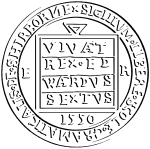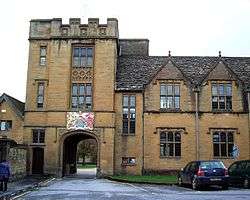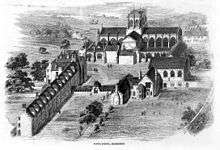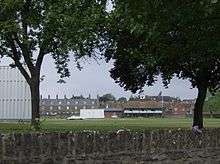Sherborne School
Coordinates: 50°56′49″N 2°31′05″W / 50.947°N 2.518°W
 | |
| Motto |
Dieu et mon droit (God and my right)[1] |
|---|---|
| Established | 1550 (8th century?) |
| Type |
Public school Independent day and boarding |
| Religion | Church of England |
| Headmaster | Dr Dominic Luckett[2] |
| Chaplain | Rev Dr David Campbell |
| Chairman of the Governors | Roger Fidgen[3] |
| Founder | St Aldhelm |
| Location |
Abbey Road Sherborne Dorset DT9 3AP United Kingdom |
| DfE URN | 113918 Tables |
| Staff | 165 |
| Students | 543 pupils as of January 2018 |
| Gender | Boys |
| Ages | 13–18 |
| Houses | 8 |
| Colours |
Royal Blue & Gold |
| Publication | The Shirburnian |
| Former pupils | Old Shirburnians |
| Website |
www |
Sherborne School is a British independent boys' school, located in the town of Sherborne in north-west Dorset, England. It is one of the original member schools of the Headmasters' and Headmistresses' Conference. It has close partnerships with the nearby girls' school Sherborne Girls, with whom it shares many academic, co-curricular and social activities.
History


The school's origins date back to the 8th century, when a tradition of education in Sherborne was begun by St Aldhelm. According to legend, Alfred the Great was one of the school's early pupils. The school was then linked with Sherborne Abbey, formerly a Benedictine house. The earliest known Master was Thomas Copeland in 1437. After the Dissolution of the Monasteries, Edward VI re-founded the school in 1550 as King Edward's School, a free grammar school for local boys. The present-day school stands on land which once belonged to the abbey's monastery. The library, chapel and headmaster's rooms, which adjoin the Abbey Church, are modifications of its original monastic buildings.
In the Beckett Room below the library there survives Anglo-Saxon masonry, a reminder that the school occupies all that remains of the site of Sherborne Abbey (AD 705, remodelled as a Benedictine abbey in 998). The headmaster and the senior staff now have their offices, appropriately enough, in the Abbot's house, rather grandly refashioned, like the Abbey itself, in the 15th century; the library was, perhaps, the Abbot's "Guest Hall" (13th–15th century); the chapel occupies another monastic refectory (12th–15th century, but much rebuilt and extended in the 19th century). Go just beyond the headmaster’s block and face the Abbey and you can see quite clearly on the walls to your right the outlines of the monastic cloister with its curious first floor Abbot’s Chapel; the conduit, where the monks washed, was removed by the Victorians and rebuilt outside Bow House.
The school's 2016 and 2017 scores for A level place it in the top 1% of all schools in England.
Music is a Sherborne tradition. Many boys achieve grade 8 distinctions for voice and a range of instruments. Several boys each year also pass their ATCL diplomas, many with distinction. Some then go on to take their LTCL diplomas[4]. In 2015 The Week magazine named Sherborne as the best school for music.
In 2005, Sherborne School was one of 50 of the country's leading independent schools that were found guilty of running an illegal price-fixing cartel, which had allowed them to drive up fees for thousands of parents.[5] Each school was required to pay a nominal penalty of £10,000. All schools involved in the scandal agreed to make ex-gratia payments, totalling £3 million, into a trust. The trust was designed to benefit pupils who attended the schools during the period in respect of which fee information was shared.[6] However, Jean Scott, the head of the Independent Schools Council, said that independent schools had always been exempt from anti-cartel rules applied to business, were following a long-established procedure in sharing the information with each other, and were unaware of the change to the law (on which they had not been consulted). She wrote to John Vickers, the OFT director-general, saying, "They are not a group of businessmen meeting behind closed doors to fix the price of their products to the disadvantage of the consumer. They are schools that have quite openly continued to follow a long-established practice because they were unaware that the law had changed."[7]
Sherborne International
Sherborne International is an independent co-educational boarding school, owned and governed by Sherborne School. It was established in 1977 for those from non-British educational backgrounds who wish to improve their English language skills before moving on to study at boarding schools elsewhere in the United Kingdom. It is located in Sherborne, occupying its own campus, Newell Grange, but sharing some facilities with Sherborne School.[8]
- Qatar branch
Two sister schools (one prep and one senior) have been established in Doha, Qatar. The prep school was established in 2009 and the senior school in 2012.[9]
Houses
As Sherborne is predominantly a boarding school, the house system is based on the boarding programme. Each house has around 70 boys with a mix of both boarders and day pupils. Day boys are fully integrated into after-school and weekend programmes.[10] There are eight houses:
- School House
- Abbey House
- The Green
- Harper House
- Wallace House
- Abbeylands
- Lyon House
- The Digby
Extant boarding houses
| House | Letter | Date | House Colour | No. pupils as of Jan 2018 |
|---|---|---|---|---|
| School House | a | 1860 | Magenta and black | 73 pupils |
| Abbey House | b | 1868 | Purple and black | 65 pupils |
| The Green | c | 1865 | Yellow and black | 70 pupils |
| Harper House | d | 1873 | L-Blue and black | 68 pupils |
| Wallace House | e | 1931 | Red and blue | 65 pupils |
| Abbeylands | f | 1872 | Red and black | 65 pupils |
| Lyon House | g | 1912 | D-Blue and black | 61 pupils |
| The Digby | m | 1964 | Green and black | 76 pupils |
Defunct boarding houses
| House | Letter | Dates | House Colour |
|---|---|---|---|
| Westcott House | h | 1920-1999 | White and black |
| Mapperty House | g | 1885-1890 | White and black
(later used by Westcott) |
| Ramsam House | N/A | 1868-1890 | Blue and black
(later used by Lyon) |
Chapel
The school chapel was originally the Monastic Hall (12th–15th century) for the abbey and was acquired by the school in 1851 from Lord Digby. It was restored and in 1855, consecrated as a chapel, dedicated to St John the Evangelist. In 1865, it was extended westwards and in 1879, northwards. In 1922, the war memorial extension was built westwards and northwards to create the antechapel, with the names engraved of those who died in the Great War, and an area for the, then, new organ.
There are two organs in the chapel: one is a pipe organ;[11] the other is a virtual organ[12] with the specification of the Hereford Cathedral Organ. Sherborne School is the first independent school in England to have a virtual organ.
Music
Music is an important part of the school and the school has been named the top independent school in the country. The "new" music school was purpose-built in 2010 and won the ORMS architecture design award in 2012.
There are two choirs, two barbershop groups, symphony orchestra, sinfonia, chamber orchestra, concert and radio orchestras (Trinity term only), wind band, string, wind, brass and jazz ensembles and various other smaller instrumental ensembles. There is also an amphitheatre for outdoor performances.
There are two Abbey services a week which are accompanied by the choir. Once a term the chamber choir sings for a service in an external venue. These include: Salisbury Cathedral, Winchester Cathedral and various Oxford College chapels, amongst numerous others, as well as these, international tours are available for various ensembles.
The school song is Carmen Saeculare.[13] Only the first and last verses are sung nowadays, with which the whole school (including staff) join in.
Annually, there is a rock-concert event aptly named "Concert in the Courts" with boys and girls from the local senior schools performing and coming to watch. In 2016, it was featured in The Telegraph.[14]
Library
The library was, like the chapel, part of the Monastic Hall (13th-15th century: later origin). Later, it was a silk mill and later still, perhaps, a brewery. It was acquired by the school in 1851 and restored in 1853. The Upper Library was used as the main school assembly room up until 1879 (when the Big School Room was built) and has been used as the main school library since. The Lower Library/ current Westcott Room was used for a time as three classrooms, and later, a headmaster's office, but since 1926 it has been used as the Lower Library.
Sport
Grounds

The school's cricket ground – the Upper – is usually used by the 1st XI cricket team. The ground was first used in 1870, when Sherborne School played Clifton College.[15] The ground is also one of the venues used by Dorset for their home fixtures. Dorset played their first match on the ground in the 1902 Minor Counties Championship against Devon. From 1902 to 1997, the ground played host to 69 Minor Counties Championship matches, with the final Championship match involving Dorset coming in 1997 when they played Herefordshire.[16] In addition, the ground has hosted 13 MCCA Knockout Trophy matches, the last of which was in 2008, when Dorset played Buckinghamshire.[17]
The ground has also played host to a single List A match, when Dorset played Bedfordshire in the 1968 Gillette Cup.[18]
On 30 May 2010, Dorset played Somerset, which included international players such as Craig Kieswetter in a friendly Twenty20 fixture on the ground. On 27 May 2011, the Upper hosted Dorset against Gloucestershire.[19]
Rugby
Rugby has been played at Sherborne since 1846; it was the third school to take up the sport, after Rugby itself and Cheltenham.[20] The school competes in an invitational tournament, Veterrimi, involving the oldest rugby-playing schools.[21] The school has played over 100 matches against local rivals Downside, and the Pilgrims (Old Shirburnians) played their 100th match against Radley in 2015.[22] Robert Hands, a former sports journalist for The Times, has written a history of rugby at Sherborne School.[23]
Headmasters
- 1437– Thomas Copeland
- 1449– Gibson
- 1553– Thomas Coke
- 1560–1561 Francis Myddelton
- 1561–1561 Thomas Parvys
- 1563–1565 William Wolverton
- 1565–1565 John Delabere
- 1565–1573 John Hancock
- 1575–1581 Rev Thomas Seward
- 1581–1601 William Wood
- 1601–1603 Rev John Geare
- 1603–1639 George Grove
- 1639–1641 Richard Newman
- 1641–1653 Ralph Balch
- 1653–1663 Rev William Birstall
- 1663–1670 Rev Joseph Allen
- 1670–1683 Joseph Goodenough
- 1683–1694 Rev Thomas Curgenven
- 1694-1696 Thomas Creech[24]
- 1695–1720 Rev George Gerard
- 1720–1733 Rev Benjamin Wilding
- 1733–1743 Rev John Gaylard
- 1743–1751 Rev Thomas Paget
- 1751–1766 Rev Joseph Hill
- 1766–1790 Rev Nathaniel Bristed
- 1790–1823 Rev John Cutler
- 1823–1845 Rev Ralph Lyon
- 1845–1850 Charles Penrose
- 1850–1877 Daniel Harper
- 1877–1892 Rev Edward Mallet Young
- 1892–1909 Rev Frederick Brooke Westcott
- 1909–1927 Charles Nowell Smith
- 1928–1933 Charles Lovell Fletcher Boughey
- 1934–1950 Alexander Wallace
- 1950–1970 Robert William Powell
- 1970–1974 David Emms
- 1974–1988 Robin Donnelly Macnaghten
- 1988–2000 Peter Herbert Lapping
- 2000–2010 Simon Flowerdew Eliot
- 2010–2014 Christopher J Davis
- 2014–2015 Ralph Barlow[25]
- 2016– Dr Dominic Luckett[26]
Ushers
The Usher, or Lower Master, was an official appointed by the Governors, independent of the Headmaster; he was required to have attained at least a B.A. from Oxford or Cambridge, and he may have been in Holy Orders. From the fragment of an account Roll, still extant, dating from 1549, there is evidence that there was an Usher before the Refounding in 1550, but unfortunately the name of the then Usher is not given.[27] The office was abolished in 1871,[28] although the title was later briefly revived to denote the Senior Deputy Head.[29]
[O.S.] = Old Shirburnians
- 1560 Henry Bagwell, B.A.
- 1561 John Martin, B.A.
- 1563 Thomas Penye, B.A.
- 1565 Rev George Holman, B A.
- 1569 Nicholas Buckler, B.A.
- 1570 Rev Hammet Hyde, B.A.
- 1572 Rev Walter Bloboll, B.A.
- 1573 John Elford, B.A.
- 1574–1581 No name given
- 1581 [first name not given] Wornell
- 1581 Philip Morris, B.A.
- 1584 Rev Lawrence Fuller, B.A.
- 1589 John Rooke, M.A.
- 1595 William More, M.A.
- 1605 George Gardiner, B.A.
- 1611 Rev George Harrison, B.A.
- 1625 Rev Randell Calcott, B.A.
- 1629 Rev Richard Camplin, [degree not given]
- 1629 John Jacob, B.A.
- 1635 John Mitchell, B.A.
- 1638 Rev [first name not given] Proctor
- 1638 Rev John Fyler, B.A.
- 1647 Thomas Martin B.A.
- 1664 Jonathan Grey, B.A.
- 1667 John Walker, M.A.
- 1667 Rev William Plowman, M.A. [O.S.]
- 1675 Rev Peter Blanchard, B.A.
- 1682 Abraham Forrester, B.A.
- 1695 Robert Forrester, B.A. [O.S]
- 1695 Rev John Butt M.A. [O.S]
- 1718 Rev Edward Cosins, B.A.
- 1723 Rev John Gaylard, M.A.
- 1728 James Martin, B.A.
- 1737 James Thomas, M.A.
- 1760 Rev William Sharpe, M.A.
- 1766 Rev John Bristed, M.A.
- 1779 Robert Pargiter, B.A.
- 1780 William Glasspoole, M.A.
- 1800 James Knight Moore, M.A.
- 1801 Rev William Hoblyn Lake, M.A.
- 1804 Henry Cutler, B.A.
- 1805 Rev David Williams, B.A.
- 1813 Rev Thomas James, M.A.
- 1860-1871 Arthur Mapletoft Curteis, M.A.
- 2016-17 Ralph Barlow, B.Sc.[29]
Old Shirburnans
For further details of notable people from Sherborne, see Old Shirburnians.
See also
References
- ↑ Max Davidson, State vs independent schools: Sherborne, Dorset, Telegraph (30 June 2009).
- ↑ "Sherborne School appoint new Headmaster". Western Gazette. Archived from the original on 2015-07-16.
- ↑ "Appointment of new Chairman". Sherborne School. 3 January 2015. Archived from the original on 24 January 2016.
- ↑ Forshaw, Ant. "LTCL diploma leads outstanding music exam results". sherborne.org. Retrieved 2 April 2018.
- ↑ Halpin, Tony (10 November 2005). "Independent schools face huge fines over cartel to fix fees". The Times. London. Retrieved 23 May 2010.
- ↑ "OFT names further trustees as part of the independent schools settlement - The Office of Fair Trading". Oft.gov.uk. Archived from the original on 2 April 2014. Retrieved 17 February 2013.
- ↑ "Private schools send papers to fee-fixing inquiry". The Daily Telegraph. London: telegraph.co.uk. 3 January 2004. Retrieved 17 February 2013.
- ↑ "Sherborne International". Independent Schools Council (ISC). Retrieved 10 December 2017.
- ↑ "BBC Online: Public school replica for Qatar". BBC News. UK: BBC. 6 March 2009. Retrieved 6 March 2009.
- ↑ Forshaw, Ant. "Sherborne School Independent Boys Boarding UK". www.sherborne.org. Retrieved 2 April 2018.
- ↑ Pipe organ specification, www.npor.org.uk.
- ↑ Virtual organ specification, www.npor.org.uk.
- ↑ Carmen Saeculare, oldshirburnian.org.uk.
- ↑ "Concert in the Courts". The Daily Telegraph. 2016.
- ↑ Sherborne School v Clifton College, 1870
- ↑ "The Home of CricketArchive". cricketarchive.com. Retrieved 2 April 2018.
- ↑ "The Home of CricketArchive". cricketarchive.com. Retrieved 2 April 2018.
- ↑ "The Home of CricketArchive". cricketarchive.com. Retrieved 2 April 2018.
- ↑ "Dorset County Cricket Club". Dorset Cricket Board. Archived from the original on 21 September 2013. Retrieved 17 February 2013.
- ↑ History of rugby union
- ↑ Veterrimi IV
- ↑ http://sherbornepilgrims.co.uk/wp-content/uploads/2015/06/pilgrims_booklet_2015.pdf
- ↑ Hands, Robert (2 April 1991). "Rugby Football at Sherborne School". Sherborne School. Retrieved 2 April 2018 – via Amazon.
- ↑ Courtney, William Prideaux. "Creech Thomas". Retrieved 2 April 2018 – via Wikisource.
- ↑ "Letter from Chairman of Governors announcing Headship of Ralph Barlow". Sherborne School. 8 September 2014. Archived from the original on 15 July 2015.
- ↑ "Sherborne School appoint next Headmaster". Sherborne School.
- ↑ Wildman, W. B. (2 April 2018). "A short history of Sherborne from 705 A.D". Sherborne : Bennett. Retrieved 2 April 2018 – via Internet Archive.
- ↑ "Ushers of Sherborne School" (PDF). Old Shirburnian Society.
- 1 2 "Sherborne Welcomes new Headmaster". Sherborne School. 23 March 2018. Archived from the original on 23 March 2018.